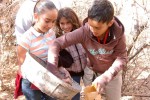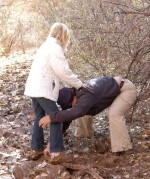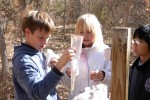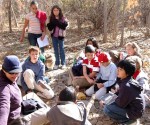Sixteen 5th graders from Cottonwood Valley Charter School (CVCS) in Socorro, NM and their teacher, Karen Gram, embarked on an adventure at the Sevilleta Bosque Ecosystem Monitoring Program (BEMP) site on Monday, October 19, 2009.
"What does B stand for in BEMP?"
I asked. Silence. Then I heard,
"Riparian forest"
quietly spoken by a girl just to my right.
"Yes! It's the forest along the Rio Grande. 'Bosque' means 'forest' in Spanish."
"E stands for ..."
"Ecosystem!"
shouted the kids.
"Yes! An ecosystem is comprised of living and nonliving things. What are some nonliving things in the bosque?"
I asked. Students answered,
"Water,"
"soil,"
"air,"
and - my favorite -
"dead leaves".
"What are some living things in the bosque?"
again I asked.
"Coyotes",
"horses,
"saltcedar"
... Well, sure - that's species-specific. Usually kids say
"trees",
Others said
"Siberian elm",
"Russian olive", and
"cottonwoods".
Wow! They really know their trees! They showed me their field notebooks with each of these species listed and drawn. "I'm impressed!" Karen told me that the BEMP education coordinator, Kimi Scheerer, worked with them on this in the classroom recently.
"M stands for monitoring. You're watching, collecting information, and writing it down. Finally, P stands for Program - you are part of a program that monitors 25 sites. So 24 other K-12 classes are out this week, just like you are, collecting data in the bosque!"
To focus the students' attention while we were on site, I asked them to create a list of animals or evidence of animals they saw, heard, or smelled. Our goal was to have at least 16 - one for every student there.
"Open up your field notebook and start writing!"
Karen said.
"Ants!"
one student observed as he looked at the ground. We got our first!
As we approached the site, I had them huddle around me.
"Something happened to the site since the last time you were here,"
I was so excited to share this with them.
"A mud flood!"
one of the children screamed..
"How did you know?"
"Kimi told us!"
(On September 17, the Rio Grande peaked at 5,000 cubic feet per second (cfs), where the mean for the past 35 years was 433 cfs, and deposited four inches of mud on our site.)
We headed in and immediately had our boots swallowed by mud. Each of our 10 litterfall tubs was filled with four inches of mud. We scooped out the mud with our hands. Some children molded clay pots from the mud. In some tubs, a thin, black layer had formed at the bottom, adjacent to the tub. I told them this mud was anoxic and had them - smell it - "Poo!" was how they described the smell.
One rain gauge was lying on the ground.
"Horses knocked it over,"
I guessed. The other rain gauge looked a little funny to me, so I checked it out. Uh oh!
"Okay kids, go ahead and beep that south well - go on, go on!"
I pulled the teacher aside and showed her the rain gauge. In it was a decomposing mouse, with a mix of gooey blood, guts, hair, a sweet mouse nose and front teeth, and maggots! I asked,
"Do you think it's okay to show the kids?"
"Oh yeah!"
She said, smiling widely.
"This is real biology!"
So I did, and that was the hit of the day! They kept on asking to see it over and over, to look from the side, from the top and from the other side. It smelled so bad that I was a little afraid of losing my lunch, but the kids took it in stride. One girl wearing cowboy boots and hat said,
"That's normal for me to see!"
I didn't know how to respond.
When the tasks were completed, we shared a list of at least 16 animals or evidence of animals that we had seen: ants, a mouse, coyote, horse, maggots, butterflies (hm, I didn't see any...), beetles, roly-polies, birds ... I can't even remember them all. Good thing they had field notebooks and wrote them all down.
Well, all fun must come to an end; some students were happy to get out of that mud-infested place. Some were hungry, some ready to go back to school. Some were tired after being so excited. As we turned around to head back, one boy showed me his triangular clay pot, housing an earthworm. Another animal!
For the icing on the cake, we saw tracks in the mud from a porcupine while we were leaving.... What a cool day. Man, I am tired!

 Enlarge this image
Enlarge this image



